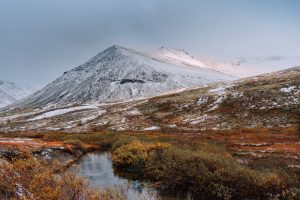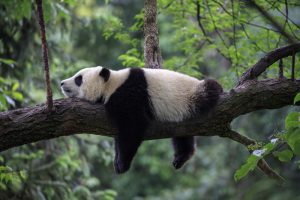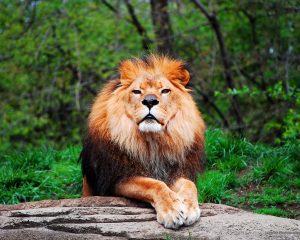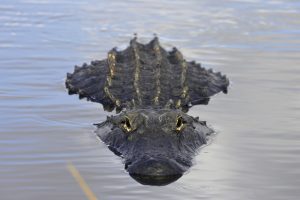Bears are mammals and are classed in the zoological family Ursidae. There are currently only eight species of bears existing in the world today.
Bears are widely distributed around the globe and can be found on all continents except Antarctica, Africa, and Australia.
The 8 different types of bears are the American Black Bear, the Asian Black Bear, Brown Bears, Giant Pandas, Polar Bears, the Sloth Bear, and Spectacled Bears.
Table of Contents
1. American Black Bear

Zoological name: Ursus Americanus
This bear has many different colors, including black, bluish-black, brown, or white (Kermode, Spirit bear).
The North American Black Bear, which is found in North America from Florida to Canada and Alaska, is the most widespread species of bear.
It is most common to see the black and brown types of the black bear.
The rarer white phase of the black bear is found in Canada’s northwest British Columbia. The black bear is an omnivore, and its diet consists mainly of vegetable matter.
At 8 years old, males attain full size and can weigh as much as 280kg (600 pounds). Females mate and have cubs when they are between 5 and 8 years old.
The black bear’s life span in the wild is about 25 years.
Although older bears have been documented in the wild, most do not reach old age because of hunting or human activity.
2. Andean, or Spectacled Bear
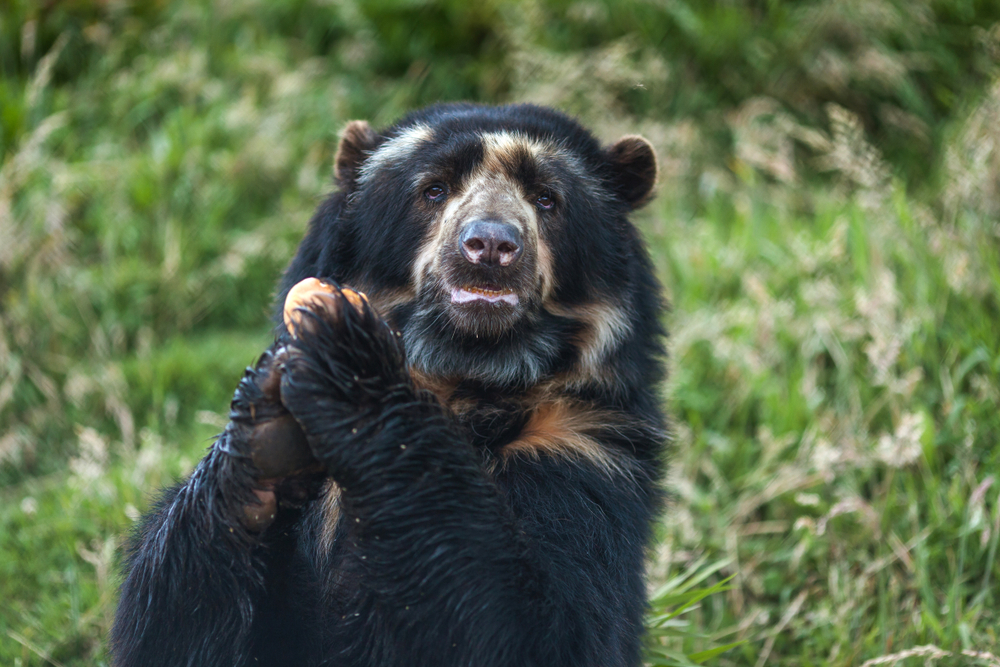
Zoological name: Tremarctos ornatus
Scientists prefer to call the South American “Spectacled bear” the “Andean bear.” Spectacled bears live exclusively in the Andes Mountains.
It is illegal to kill the bears, which are listed as endangered. It has a close genetic relationship to the Florida short-faced bears and Florida spectacled bears from the Middle Pleistocene through the Late Pleistocene ages.
The only remaining species of South American bear, the Spectacled bear is the only living member of the Tremarctinae subfamily.
The Spectacled bear is the biggest land carnivore in South America, and it may come as a surprise that only five percent of its diet is meat.
The Spectacled bear is medium-sized, and although its overall color is blackish, bears can vary in their fur color from jet black to dark brown to reddish.
The species often has a distinct fawn-colored pattern on its face and upper chest; however, not all Spectacled bears have these markings.
Bears can easily be distinguished by the differences in the pattern and number of pale markings.
Males can be two times larger than their female counterparts in size and weight, sometimes three times as large – males can weigh between 220 to 440 lbs while females can reach 77 to 181 lbs.
Their length can vary from 47–79 in. with a tail that measures 2.8 in. and shoulder heights of 24–30 in.
This species is more rounded than other bears and has a shorter, wider snout. This same facial structure has been found in some extinct species.
Some fanciful and unproven speculations suggest that snouts like this were “adapted” to suit its mainly herbivorous diet.
There is no proof of this, of course, nor is there a way to disprove it (Karl Popper’s theorem of falsifiability).
3. Asian Black Bear
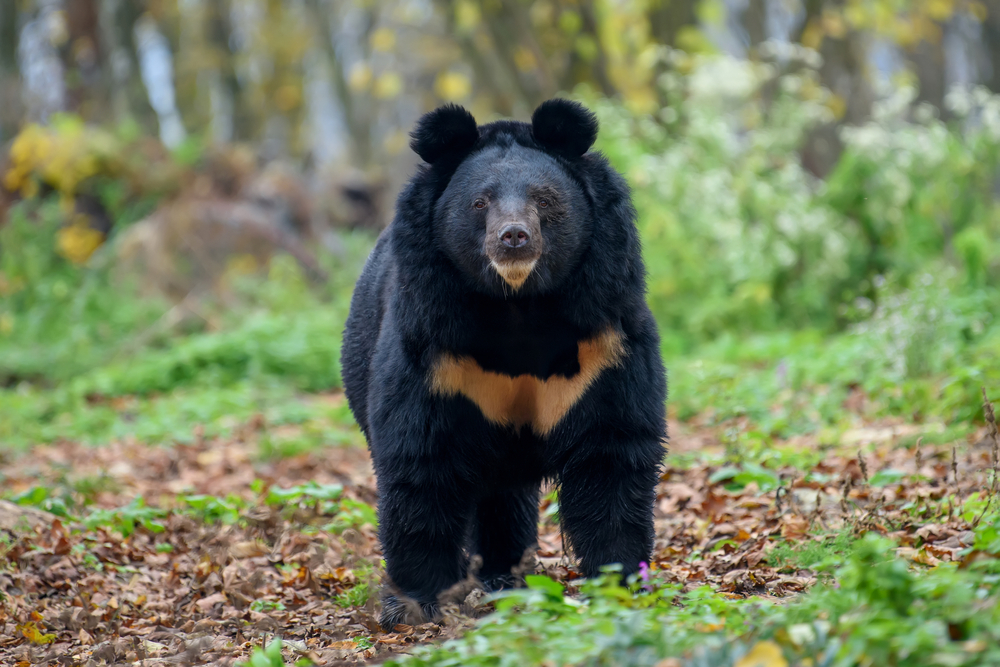
Zoological name: Ursus Thibetanus.
This bear is also called the Moon bear or the Himalayan black bear. Asiatic black bears are known for their long, black fur and distinctive white patches on the chest. This patch is often crescent-shaped.
Their ears are large, and the fur around their shoulders and throats is especially long. Asiatic black bears live and roam about in eastern Asia.
They can be found in Afghanistan, Bangladesh, Bhutan, China, India, Taiwan, the Russian Federation, Pakistan, Nepal, Myanmar, Mongolia, Malaysia, the Lao People’s Democratic Republic, the Democratic People’s Republic of Korea, The Republic of Korea, Japan, and the Islamic Republic of Iran.
Although less so than American bears, Asiatic black bears are still quite carnivorous. Small mammals, birds, fish, and mollusks are all included in its varied diet.
They also eat grasses, fruits, berries, seeds, and honey. Like most bears, they gain weight in autumn by eating nuts to prepare for winter. They hibernate in northern climates but do not hibernate in southern climates.
4. Brown Bear
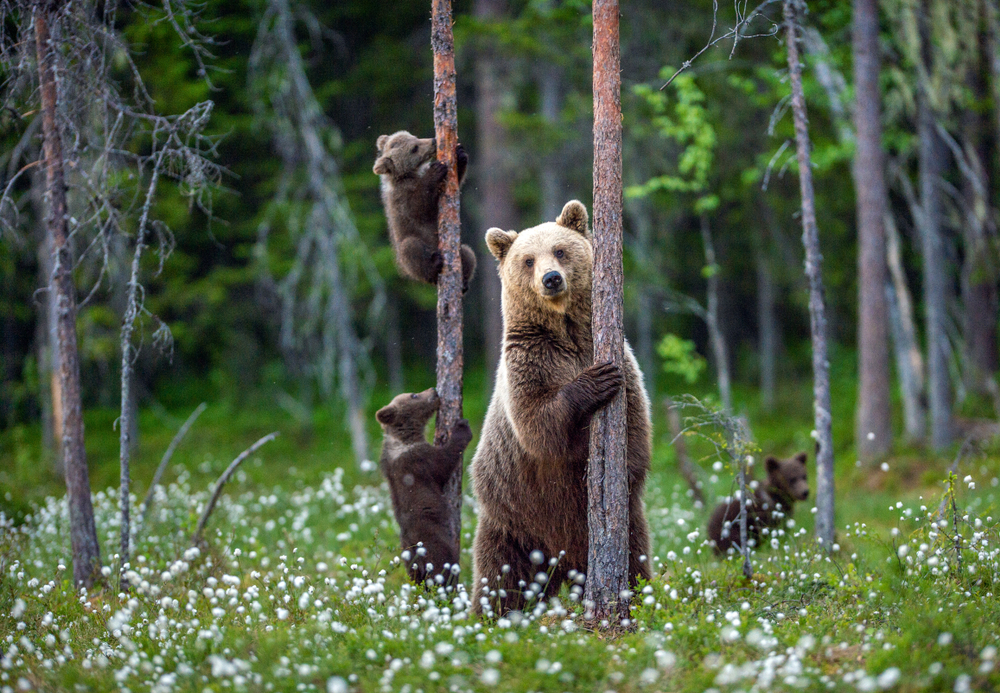
Zoological name: Ursus Arctos
The Brown Bear is found in Alaska, Washington, Montana, Wyoming, Russia, and Canada. There are also small populations scattered across Asia and Europe.
Brown bears come in various colors, from brown and black to light brown and blonde.
The size of a bear will vary depending on where it is located and what food they have available.
The biggest bears on the planet, the “Big Browns,” are found along the coasts of Russia and Alaska. They grow to enormous sizes that rival even the Polar Bear.
The bears that live in the mountains of Europe and the interior of the Rocky Mountains in North America (grizzly bears) are generally smaller. The largest bears (1,000 lbs and more) are rare.
By the way, the Grizzly Bear has the incredibly frightening yet intriguing zoological name, Ursus arctos horribilis.
5. Giant Panda
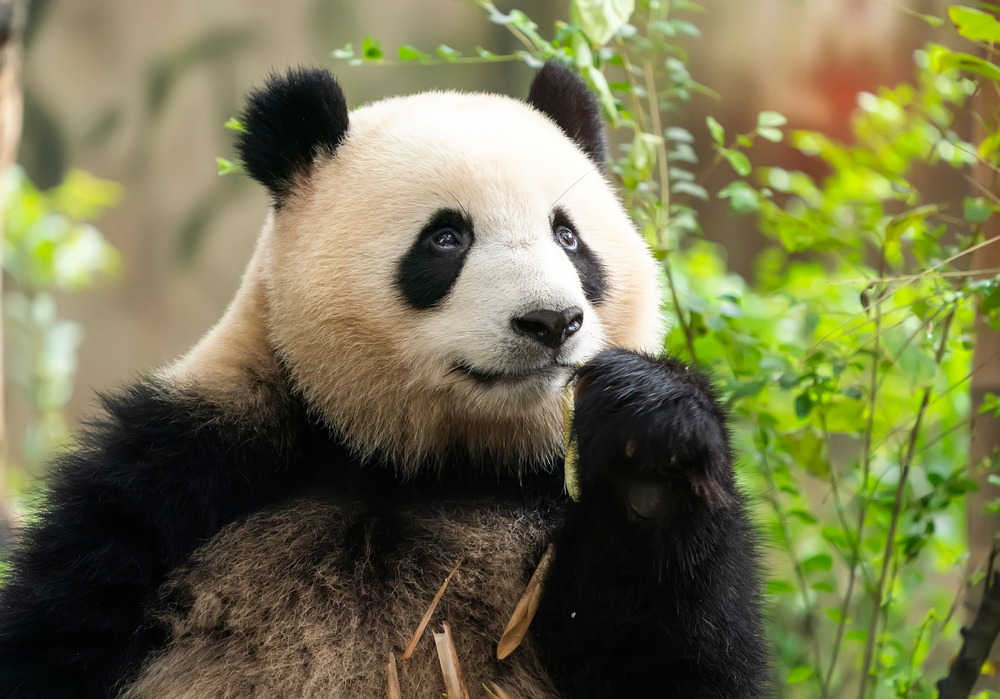
Zoological name: Ailuropoda melanoleuca
These bears reach about 5 feet high; males weigh about 250 lbs and females about 220 lbs. The giant panda, a rare and endangered bear, is very difficult to find.
Scientists used to believe the giant panda belonged to the raccoon family.
Science proved wrong with DNA analysis, and it was determined that giant pandas are unrelated to raccoon-like red pandas.
Pandas primarily eat bamboo, averaging about 44 lbs of the plant a day.
The extra digit in the panda’s hand allows them to tear the bamboo to protect themselves from splinters. Their gut is also covered with thick mucus to help protect their digestive system from the fibrous plant.
Loss of their habitat is the main reason for the decline in the giant panda’s wild populations.
Today, their range is limited to six mountain ranges in western China.
A giant panda is born as a pink, hairless, and blind baby. Its mother weighs a whopping 900 times more than her cub when it is born!
Giant pandas don’t hibernate, unlike other bears. They move to lower elevations in winter to keep warm and higher elevations during summer to keep cool. They are active day and night.
6. Polar Bear

Zoological name: Ursus Maritimus
The Polar bear is thought to be the largest bear species on earth. Adult males can reach an incredible 1,760 lbs! According to live capture research, the largest male bear was found in Ontario and weighed 1,439 lbs.
However, male polar bears average 1,100 lbs with adult female bears averaging 660 lbs. Unlike some other bear species on this list, these Polar bears have been known to actively hunt humans.
Some small villages in Alaska and Canada even have alarms systems to alert their residents if a nearby bear wanders into town.
As their name suggests, Polar bears live near the North Pole (not the South pole) in Alaska, Canada, Finland, Norway, Greenland, and Russia.
7. Sloth Bear
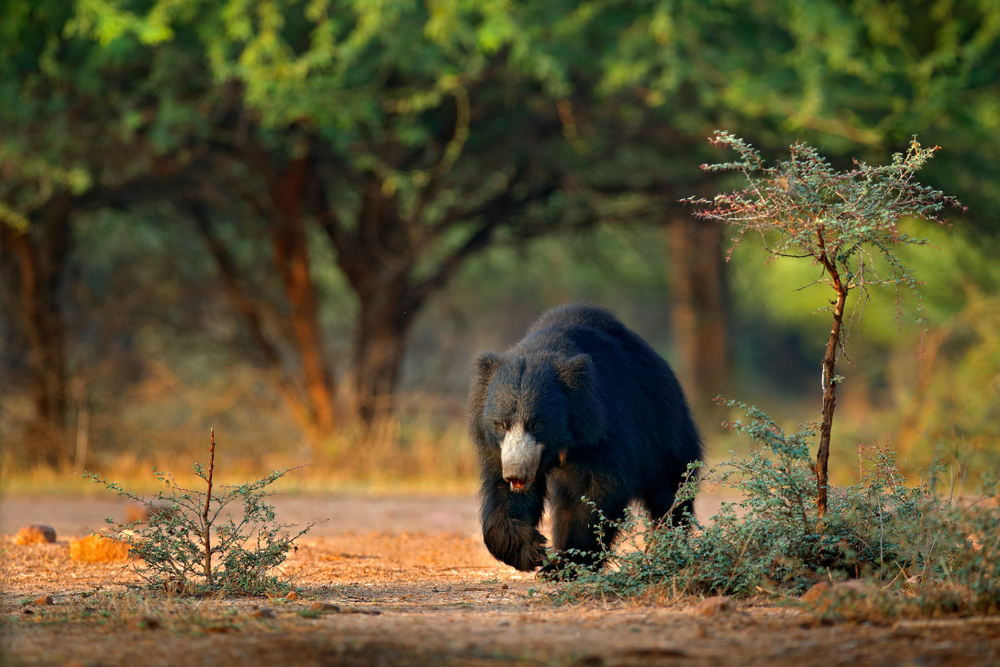
Zoological name: Melursus (Ursus) ursinus.
There are also two subspecies of this bear, the Sri Lankan Sloth Bear and the Indian Sloth Bear.
The stocky sloth bear is tall with long, black hair and a U or Y-shaped mark on its chest. They are large with long, pale lips and a wide mouth.
These shaggy-haired bears are often heard sucking termites from their mounds, even from a distance. Their hook-like claws allow them to dig up termites and even climb trees. They are found in Bangladesh, Nepal, Bhutan, India, and Sri Lanka.
Sloth bears are active in the nighttime. Unlike some other bears, sloth bears don’t seem to mind sharing their home territories with other sloth bears.
The average home range for male sloth bears is 13 km2.
This is a smaller range than other bears because they don’t experience seasonal fluctuations in food supply (ants and termites are always available).
They don’t need to hibernate because of the constant availability of their food sources.
8. Sun Bear
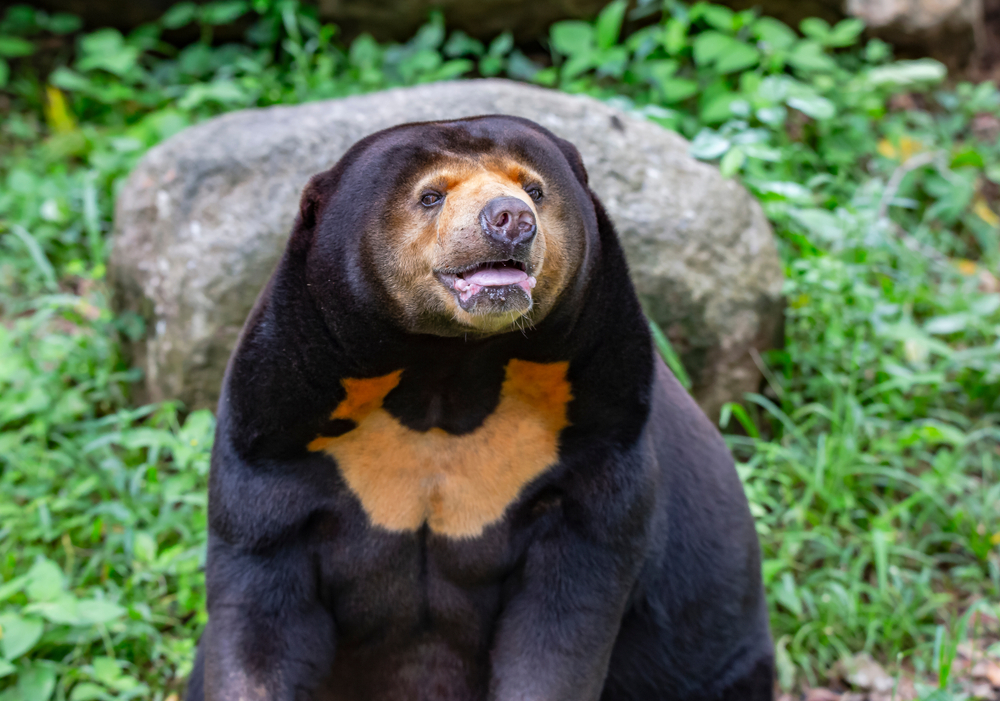
Zoological name: Ursus malayanus
Sun bears are the smallest bear species and have short fur with a yellow crescent on their chest. The fur is water-repellent and dark brown in color.
Their strong paws have long, sickle-shaped claws and naked soles. Their flexible snouts aid in their ability to extract termites from nests.
Among all the bear species alive today, sun bears have the longest canines of all relative to their size.
Sun bears, however, are not carnivorous –sun bears use their sharp teeth as tools to tear open tree bark and get at the insects buried within, or as defensive weapons.
In south-east Asia, Sun bears can be found in Vietnam, Thailand, Myanmar, Malaysia, Lao People’s Democratic Republic, Indonesia, India, China, and Cambodia.
Frequently Asked Questions
Do any bears live in Africa?
While no bears live in Africa now, once upon a time there was one species, the Atlas bear, that did.
Why don’t bears live on the African continent today? The absence of bears in Africa is surprising because they are an omnivore that can live in deserts, mountains, and forests.
However, even large bears might not withstand a pride of lions or persistent hyenas, which is a likely explanation for why there are no bears living in Africa today.
Some experts do believe that if humans didn’t hunt them, there may be bears living in Nigerian and Congolese rainforests today.
When did the Atlas Bear live in Africa?
The Atlas bear is ranked as a brown bear subspecies. Atlas bears rambled around the northern regions of Africa from ancient times right up until the 19th century.
In those days, bears would have been seen roaming the Atlas Mountain range from Libya to Morocco.
The origins of the Atlas bear are unknown, and genetic analysis has not revealed any connection to brown bears. Strangely, the genetic analysis did reveal low-signal, yet important mtDNA connections to polar bears.
Paleolithic cave paintings of bears in Andalusia in Spain may in fact be atlas bears.
A bear could make the crossing between the narrowest part of the Mediterranean between Europe and Africa in a matter of hours to reach the Atlas Mountains.
Africa’s only native bear, the Atlas bear, did make it into the modern age. As such, we know the muzzle of this now-extinct bear was dark brownish-black and that they featured a firey-orange underbelly.
The fiery orange underbelly fur was characteristic of the Atlas bear.
What caused the disappearance of the Atlas bear from Africa?
The Roman Empire played a key role in the disappearance of the Atlas bear. Romans would capture bears and use them in arenas throughout Europe.
Crowd-adulated gladiators were prepared to fight bears in large numbers. As such, Atlas bear populations were decimated by humans.
When did Europeans discover the Atlas bear?
The Atlas bear, also known as the African bear, is the only Ursinae bear native to Africa.
Observations made by an English military commander named Crowther returned the Atlas bear to the attention of Europeans for the first time since the Roman Empire.
This marked the first occasion that the new and growing scientific community acknowledged the bear’s existence.
Why did the Atlas bears vanish?
In addition to overhunting and being used for sport, zoo collectors created additional problems for Atlas bears. They often separated them from each other and prevented them from reproducing and flourishing.
When exactly did the Atlas bear go extinct?
Not long after being discovered and reported by Crowther, the Atlas bear became extinct at the end of the 19th century and Africa lost its only bear.
In Roman times, which was considered fiercer, Atlas bears or lions?
Of course, by modern standards, the incredible cruelty of the ancient Romans was inexcusable, but – and this is no excuse – it did lead to some insight about Atlas bears.
By matching starving Atlas bears against equally hungry lions, the ancient Romans proved that Atlas bears were no match for lions.
What was the Agriotherium Africanum Miocene-period bear?
Agriotherium Africaum was another bear species that once lived in Africa. It weighed approximately 900 kilograms and stood 8.8 feet (2.7 meters) tall. This bear was twice as large as today’s largest bear.
Think of a world in which bears that weighed nearly a ton roamed Africa’s plains.
Scientists discovered archaic bones belonging to bears in sub-Saharan African areas like Ethiopia and South Africa. These bears were present millions of years ago, and they are very different from those we have now.
Agriotherium Africaum was the most powerful bear we know of with the largest bite ever recorded. The bears’ sheer size suggests that they could bully other animals, including horses, camels, and rhinoceroses.
However, this African bear was thought to have been an omnivore and would have enjoyed eating plants and fruit.
Agriotherium is supposed to have disappeared over two and a half million years ago, at the end of the Pliocene period.
This giant bear is believed to have been driven to extinction by competition from a growing number of meat-eaters and climate change.
Are Koala Bears real bears?
Apparently, koala “bears” are not a bear type. And scientifically, their name doesn’t include “Ursus” or “bear” at all.
Koalas are actually marsupials, just like possums, wombats, wallabies, and kangaroos.
Female marsupials possess a unique feature named a “marsupium,” which is a pouch in which their young can hide safely after birth.
However, the pouch of a female koala opens downwards, instead of upwards, unlike most of the other marsupials.
According to some, the term “koala bear” comes from 18th-century settlers who spoke English. They would often name animals that were new to them based on the animal they knew.
These settlers also used to call koalas “monkey bear”, “sloth”, “tree-bear”, or other similar names.
Although koalas look soft and cuddly, their fur most definitely is not. Their fur isn’t as fluffy and soft as it seems but has a woolier consistency.
It would be like cuddling with a sheep, but one that has a fearsomely strong grip and long claws. They are also very independent animals and prefer to be alone most of the day, making them terrible and antisocial pets.
A popular legend about koalas that is, in fact, complete nonsense, is that they spend all day sleeping because they get drunk from all the eucalyptus they eat.
In reality, they have a slow metabolism, and it takes a while for their digestive systems to process the leaves. Interestingly, eucalyptus leaves usually poison most animals.
Koalas eat almost exclusively eucalyptus leaves, which bring very little nutritional and caloric value to their diet.
They must sleep for up to 20 hours each day to conserve energy and allow their digestive systems and microbes to digest their (somewhat monotonous) meal of eucalyptus leaves.
Is it safe to have bird feeders in an area where there are lots of black bears?
Bird feeders should be avoided if you live near bears.
Bears who find bird feeders will return to the same spot year after year. Bird feeders, birdseed, corn, and other bird foods can bring bears closer to people and sometimes lead to them losing their fear of humans.
Bears will start to use human-associated food resources and they will be more likely to go into residential areas. They may also break into homes or outbuildings if they are harassed or smell something tasty.
You should not put out feeders in winter when bears can access them. Bears typically stay in dens from mid-December to February. Bears in Massachusetts usually enter winter dens around mid-December.
However, some bears may remain active throughout the winter if there is food. You should remove all feeders at the first sign that bear activity occurs.
Some bears can empty feeders and not damage them. If a bear eats the seed, do not continue filling the feeder.
Experts suggest that people employ water features and plants local to the area to attract birds to their yards. These methods can increase the variety of birds you see and prevent the artificial feeding of many wildlife species.
Is hiking, running, biking, or walking the dog safe where there are black bears?
No matter where you live, it is safe to be outside. However, when outside, ensure your dog is always under your control. Be aware of your surroundings and use caution if you see a bear.
Speak to the bear calmly if it is aware of your presence. If the bear doesn’t know you are there, move away slowly.
What is the best thing to do if there is a black bear in the yard?
Enjoy the sighting of a black bear in your backyard. But make sure you don’t do anything to attract it to your yard. To scare the bear away, make noise with your voice, banging pots and pans or shouting.
After the bear leaves the area, look around your yard for bear food sources, such as pet food, bird feeders, trash, open compost, or dirty barbeque grills.
Bears can recall where they found food for many years and will return to the same places months later. Bears frequently fed, whether directly or indirectly, by bird feeders or garbage can lose all fear of humans.
A bear that behaves in a manner that poses a danger to public safety may have to be put down.
Why do black bears seem to be attracted to certain neighborhoods?
Bears love to spend time in neighborhoods where food sources such as bird feeders and open compost containers are plentiful and easily accessible.
A bear will return to the same area repeatedly once they have found a food source. They will also search other nearby locations for similar sources of food.
Bears drawn to human-related food sources could be more at risk of being struck by cars and might lose their fear of people.
Why are black bears destroyed if they become a nuisance instead of being relocated?
Bears who frequent homes, businesses, or facilities are more likely to be attracted to food sources than those that do not. The best option for both the bear and the people is to remove the attractant.
Massachusetts’ bear range is extensive and growing. Bears can travel long distances, so it is not always feasible to relocate them because they will travel great distances to return home.
Once they are back, they will not stop being nuisance animals for as long as the food is available.
However, wildlife workers prefer that the bear is released into its natural habitat, or as close as possible.
More often than not, nuisance situations can be avoided peacefully simply by changing human behavior and removing the sources of food that are attracting the bear.
Wildlife workers will destroy bears in extreme cases where safety is a concern, but of course, these workers will do everything in their power to avoid having to take such actions.
The situations where an animal has to be euthanized involve bears in densely populated areas. This raises a public safety concern due to their proximity to traffic and people.
What is the best thing to do when coming face to face with a black bear?
Keep calm and speak calmly to the bear. Make yourself larger by raising your arms high above your head if a bear approaches you or follows.
Keep repeating “Hello, bear!” in a relaxed, soothing voice. The bear will often move on to another area.
If the bear keeps following you, stand firm, look larger, and shout at it with whatever tool is at your disposal. Bang a stick, clap your hands, or use bear pepper spray, if available.
You should move away if the bear stops following or turns around. Use whatever you have to fight back against the bear if they charge you.
For example, a stick, binoculars, swinging a backpack, etc. are all good options. Bear pepper spray is also available for aggressive bears.
How do we refer to male and female bears?
Male bears are called “boars”, while female bears are called “sows.”
Because we use the same terms to refer to male and female bears and pigs, many people wonder if the two are related.
Pigs and bears are unrelated except that both are mammals. Bears are not related to pigs, dogs, or cats.
What is the collective name for a group of bears?
The collective name for bears is “sloth.” So, for example, “There is a sloth of bears fishing for salmon at the head of the next river” is the correct way of saying, “There is a group of bears fishing for salmon…”
Are cub and adult bear teeth different?
Nearly all mammals experience a period in their lives when they have baby (or “milk”) teeth and then they grow adult teeth. Bears are no different.
Is it true that bears can “hoot”?
According to an urban legend, the Northeastern United States has black bears that “hoot.” This is a myth, however.
After exhaustive research, the general consensus is that the only evidence of bears hooting is anecdotal and therefore, a myth.
Final Thoughts
There were far more species of bears in ancient times than there are now.
Many of the bear species have disappeared due to climate change, other animal species, and man’s dangerous and unfortunate influence, leaving only the eight species we’re familiar with today.
Of the eight species of bear today, the giant panda is most in danger of becoming extinct. Luckily, a lot of effort is going into preserving these bears.



